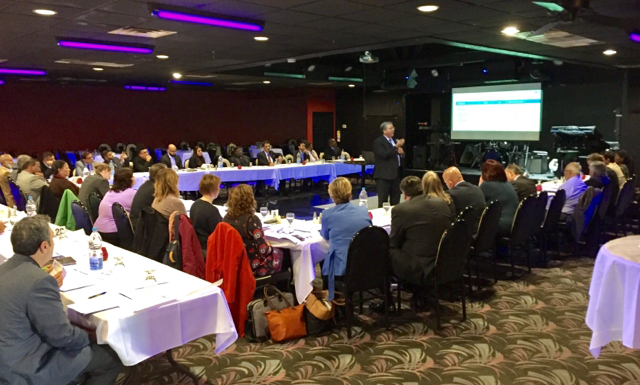To Prevent Extremist Violence in the United States, Think Beyond the Homeland Security Box
Other agencies can better promote CVE initiatives by building bridges to communities and taking a less security-focused approach.

Published by The Lawfare Institute
in Cooperation With

Editor’s Note: The Department of Homeland Security has long taken the lead in U.S. programs to counter violent extremism (CVE). This has contributed to concerns about the over-securitization of CVE programs. Eric Rosand, a Brookings nonresident senior fellow, and Stevan Weine of the University of Illinois argue that Homeland Security should play less of a role in running CVE programs and that the Department of Health and Human Services should step up its involvement.
Daniel Byman
***
Over the past decade, with the FBI focused on surveilling and otherwise investigating suspected terrorists, the United States has relied on the Department of Homeland Security to work with local law enforcement, municipalities and communities to strengthen their capacity to prevent violent extremism. Under President Obama, the department provided risk awareness briefings; advised on pilot implementation projects in Boston, Los Angeles and Minneapolis; co-led an interagency task force focused on countering violent extremism (CVE) in the United States; and set up an office focused on building partnerships with communities. The Office for Community Partnerships administered seed grants to support community-based projects, focused in particular on Muslim communities, to foster trust between law enforcement and the populations they serve, and to prevent and intervene with individuals radicalizing to violence. The projects included, for example, work to build trust between the Boston police and the local Somali-immigrant community through a police-led mentorship and skill development program for Somali American youth that resulted in “increases in protective factors and skills in the youth (e.g. conflict resolution) as well as more engaged and informed police officers who’ve participated in the mentorship program.”
Compared with the initiatives taken in other countries, these were truly baby steps, and they were met with mixed responses, with some community groups refusing to cooperate because they perceived the initiatives to be discriminatory and possibly masking surveillance efforts. After dismantling much of the Obama-era Homeland Security CVE architecture, the Trump administration resurrected it in late 2019, replacing the unpopular and often controversial “CVE” lexicon that was perceived as being too-often focused on Muslim communities with a “terrorism and targeted violence prevention” framework that explicitly included white supremacist violence as well as nonideologically motivated violence. In addition, this year the administration rolled out a follow-on Homeland Security grants program to support locally led initiatives, informed by the lessons from the Obama-era grants. These decisions left a glimmer of hope that Homeland Security was on the path to developing the kind of trusting relationship with local partners necessary to allow the department to work together to prevent extremist violence from taking root in their communities.
Yet Homeland Security as an organization remains focused on security, as its name suggests, and recent departmental involvement in widely condemned immigration and anti-protest measures has probably added to doubts about its concerns for and credibility in local communities. Some policymakers, including former national security official Richard Clarke, have even called for it to be dismantled. Our research and experience shows that the department’s emphasis on security can be counterproductive and that the most promising strategies can be found in models and partnerships led by actors not involved in security. It is time to consider turning the page of the past decade of Homeland Security-focused efforts by ending the targeted violence and terrorism prevention program and committing to new prevention models that offer a better fit with the community-based work required to make progress against the still growing violent extremist threat in the United States.
This will involve programs run and supported by different federal bureaucracies, particularly the Department of Health and Human Services (HHS)—which would work in partnership with local social, health and youth workers; local police; and communities more broadly, as well as other federal agencies in a supporting role. In fact, a 2019 Rand Corp. report on terrorism prevention highlighted the need for an increased role for HHS in this area as part of a shift to a public health model for CVE efforts in the United States.
In countries where trust between the interior ministry and local communities is lacking, the United States and its international partners often impress upon the host government not to have that agency be the face of a national effort in which trusted relationships with the communities it is trying to reach is perhaps the key ingredient for success. Particularly given Homeland Security’s actions under the Trump administration, the United States could be considered one such country.
As is so often the case when speaking about preventing violent extremism in the United States, there are lessons to be learned from international efforts. In Germany, the Federal Ministry for Family Affairs, Senior Citizens, Women and Youth works alongside the German Ministry of Interior, with the former focusing on community engagement and social cohesion. In Denmark, its national CVE center, the Center on Prevention of Extremism, is nested within the Ministry of Immigration and Integration and supports local collaborations among teachers, social workers, housing authorities and the police to steer those on the road to becoming violent down a peaceful path.
A cursory survey of the international landscape reveals a number of different models for funding and supporting local efforts to prevent violent extremism that don’t involve security agencies. These might come in handy now that the current Homeland Security-led approach in the United States—which has resulted in a number of local groups refusing to accept department funding even before its role in the federal response to recent political protests—seems unsustainable. These alternatives include providing non-security agencies the authorities, mandate and funding to support community-led initiatives.
In Australia’s two most populous states, Victoria and New South Wales (NSW), the state-level ministries of multicultural affairs manage grants schemes focused on building resilience and social cohesion, which are very much a part of a comprehensive approach to CVE. Since it was established in 2015, the NSW program, known as the Community Partnership Action (COMPACT) program, has reached 40,000 young people through 24 projects that involve an alliance of more than 60 partner organizations. The program just received an additional $2.15 million to expand its work over the next year.
In the United States, this could mean getting HHS and/or its state and local equivalents to initiate grants programs focused on preventing violent extremism in their communities, replacing the Homeland Security effort. Among other things, a shift from Homeland Security to HHS would be a shift away from the law-enforcement-dominated approach that has characterized and hindered CVE efforts in the United States over the past decade. Transitioning to an HHS-led model is long overdue and would facilitate efforts to involve public health, mental health and social service professionals; educators; teachers; community leaders; and even family members—all of whom have too often been reluctant to get involved in CVE efforts. It would also allow for the development of the necessary multidisciplinary approaches that have so far been absent from CVE efforts in the United States.
More ambitiously, the United States could draw on international good practices in countries such as Australia, Canada, Denmark, Finland and Germany, as well as the European Union’s Radicalization Awareness Network, to develop a national violence prevention network made up of professionals and local authorities with experience in CVE or related fields, including mental health and drug or broader crime prevention. This network could ensure that communities looking to develop programs to prevent extremist violence from taking root, including by intervening with young people on the path to becoming violent, receive the necessary support from relevant professionals. Such a network could be established within the Substance Abuse and Mental Health Services Administration of the HHS, building off the highly successful precedent of the department’s National Child Traumatic Stress Network. The network could have fundraising and grant-making functions, mobilizing resources from the private sector and disbursing and overseeing the implementation of public and private funds to support community-led prevention or intervention programs.
Though HHS has slowly started to explore how to deepen its involvement in CVE (or terrorism and targeted violence prevention), it would no doubt face challenges in entering a new space. But the department can draw on its experiences administering violence prevention programs for minority youth, domestic violence, and teen bullying, which have been able to integrate public health and community policing approaches to reduce disparities in communities of color. Although HHS leadership in this space will not be a panacea, it could help increase the involvement of non-law-enforcement professionals and community-based organizations, which would better facilitate multidisciplinary collaborations and trusted partnerships that have been successful overseas but have so far remained elusive at home.






